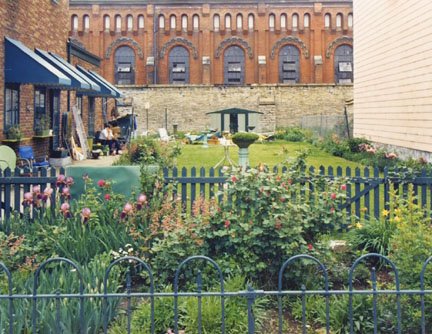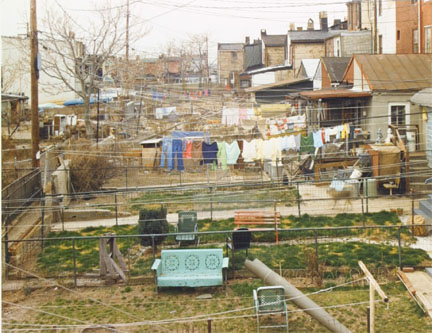About the Photographer
Teemer, Jack
American, 1948-1992
Jack D. Teemer's photographs of working-class neighborhoods in cities like Baltimore, Cincinnatti, and Pittsburgh center on the residents' backyards, observing the varied forms they take. Some of the yards are carefully landscaped, a few given over to working gardens, and others are cluttered or blatantly neglected. Many of the inhabitants use this space as a means of individual expression by adding lawn decorations or planting flowers, while metal or wooden fences—visible in every picture—mark the boundaries and serve as symbols of ownership. Teemer's photographs allow us to imagine the people who stake a claim to these personal spaces, but his photographs also register various societal factors, such as the effects of class, economic conditions, and urban zoning, with factories looming in the distance. Teemer states, “While I only expect the photographs to reveal, rather than alleviate [the residents] difficult situations, they are nevertheless both disturbing and beautiful in their portrayal of the celebration of life.â€
Photographs by their nature render the three-dimensional world as a flat image, but Teemer's photographs suggest a compression of space in a way that is especially pronounced, appearing like a set of layers stacked on top of each other. Typically, a fence rises up in the foreground, a yard and house are visible behind it, occupying most of the frame, and the surrounding city fills in around them in the background. This density creates visual interest, as different patterns, colors, and forms overlap or collide, but it also adds an uneasy element of tension, preventing the eye from resting comfortably in one spot for too long.
Teemer was born in Baltimore, and completed a BA and an MFA at the University of Maryland (1977, 1979), where he studied with John Gossage. In the early 1980s, he joined a rising generation of photographers who embraced color photography and overturned the long-standing notion that it was a low-brow medium. Photographers have been using various color processes for more than a century, and color film went on the market in the mid-1930s, but it was only in the 1970s later that color photography came to be accepted as an art form. Up to that point color was strongly associated with advertising, photojournalism, and amateur photography, and the myth persisted that only black and white images achieved the qualities of art. Color photography's apparent coming of age was partly a matter of being christened by influential museum curators like John Szarkowski, who organized a pivotal exhibition of William Eggleston's color photographs at the Museum of Modern Art in 1976. Nevertheless, the creative work of Teemer and his contemporaries, particularly certain figures like Eggleston, Joel Meyerowitz, and Stephen Shore, paved the way for the later predominance of color photographs in museums and galleries.




